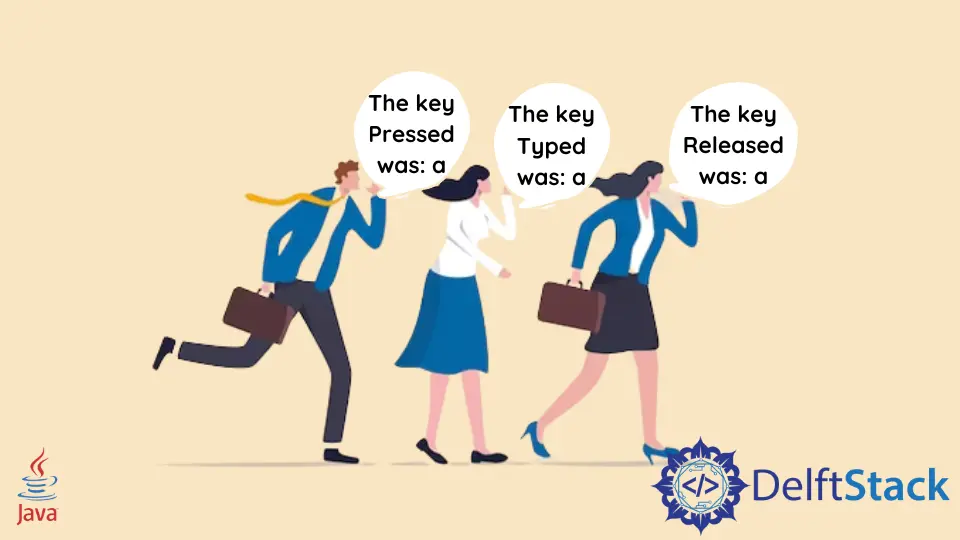在 Java 中使用 KeyListener
Mohammad Irfan
2023年10月12日
Java
Java KeyListener

本教程介紹如何在 Java 中使用 KeyListener 並列出一些示例程式碼來理解該主題。
KeyListener 是一個處理鍵盤按鍵狀態變化的介面。正如介面的名稱所暗示的那樣,它會監聽按鍵並相應地採取行動。
在本教程中,我們將學習如何實現此介面並處理關鍵事件。
KeyEvent 類
每當按下鍵盤鍵時,KeyEvent 類的一個物件就會通知 KeyListener。KeyEvent 類有一些方法可用於獲取有關按鍵事件的更多資訊。下面總結了該類中最重要的三個方法。
getKeyChar()方法獲取與事件關聯的關鍵字元。如果我們想為特定鍵新增一些功能,這種方法非常有用。例如,如果按下e,則應用程式應退出。getKeyCode()方法與getKeyChar()方法非常相似。它返回與按下的鍵相關聯的整數鍵程式碼。isActionKey()方法可以判斷是否按下了操作鍵(如 Caps Lock)。它返回一個布林值 true 或 false。
實現 KeyListener 介面
KeyListener 介面監聽按鍵事件並執行一些操作。該介面的宣告如下所示。
public interface KeyListener extends EventListener
我們需要在我們的類中重寫這個介面的以下三個方法。
keyPressed(KeyEvent e)方法將在按下某個鍵時被呼叫。- 釋放鍵時將呼叫
keyReleased(KeyEvent e)方法。 keyTyped(KeyEvent e)方法將在鍵鍵入字元時呼叫。
我們還將使用 addKeyListener() 方法。我們需要將實現 KeyListener 介面的類的物件傳遞給該方法。它是一種註冊物件以監聽和響應關鍵事件的方式。
KeyListener 的簡單應用
讓我們建立一個簡單的應用程式,它偵聽關鍵事件並向控制檯列印一些內容。我們將建立一個框架併為其新增標籤。我們的程式應該將關鍵字元和關鍵操作列印到控制檯。如果按下的鍵是操作鍵,則程式應終止。
import java.awt.FlowLayout;
import java.awt.Frame;
import java.awt.Label;
import java.awt.event.KeyEvent;
import java.awt.event.KeyListener;
public class KeyListenerExample implements KeyListener {
@Override
public void keyTyped(KeyEvent e) {
System.out.println("The key Typed was: " + e.getKeyChar());
}
@Override
public void keyPressed(KeyEvent e) {
if (e.isActionKey())
System.exit(0);
System.out.println("The key Pressed was: " + e.getKeyChar());
}
@Override
public void keyReleased(KeyEvent e) {
System.out.println("The key Released was: " + e.getKeyChar());
}
public static void main(String[] args) {
// Setting the Frame and Labels
Frame f = new Frame("Demo");
f.setLayout(new FlowLayout());
f.setSize(500, 500);
Label l = new Label();
l.setText("This is a demonstration");
f.add(l);
f.setVisible(true);
// Creating and adding the key listener
KeyListenerExample k = new KeyListenerExample();
f.addKeyListener(k);
}
}
輸出:
The key Pressed was: a
The key Typed was: a
The key Released was: a
The key Pressed was: b
The key Typed was: b
The key Released was: b
使用 KeyListener 的簡單遊戲應用程式
讓我們建立另一個將箭頭鍵作為輸入的程式。該程式將根據按下的鍵將數字 0 移動到矩陣中的不同位置。輸出被列印到控制檯。
import java.awt.FlowLayout;
import java.awt.Frame;
import java.awt.Label;
import java.awt.event.KeyEvent;
import java.awt.event.KeyListener;
import java.util.Arrays;
public class KeyListenerExample implements KeyListener {
// Matrix and x, y coordinates of 0
int[][] matrix;
int x;
int y;
KeyListenerExample() {
// Initializing the Matrix
matrix = new int[3][3];
matrix[0] = new int[] {1, 1, 1};
matrix[1] = new int[] {1, 0, 1};
matrix[2] = new int[] {1, 1, 1};
x = 1;
y = 1;
// Printing the Matrix
for (int i = 0; i < 3; i++) System.out.println(Arrays.toString(matrix[i]));
System.out.println();
}
// keyPressed() method takes care of moving the zero according to the key pressed
@Override
public void keyPressed(KeyEvent e) {
if (e.getKeyCode() == KeyEvent.VK_RIGHT) {
if (x != 2) {
x += 1;
System.out.println("Moving Right");
} else
System.out.println("Cannot Move Right");
}
if (e.getKeyCode() == KeyEvent.VK_LEFT) {
if (x != 0) {
x -= 1;
System.out.println("Moving Left");
} else
System.out.println("Cannot Move Left");
}
if (e.getKeyCode() == KeyEvent.VK_DOWN) {
if (y != 2) {
y += 1;
System.out.println("Moving Down");
} else
System.out.println("Cannot Move Down");
}
if (e.getKeyCode() == KeyEvent.VK_UP) {
if (y != 0) {
y -= 1;
System.out.println("Moving Up");
} else
System.out.println("Cannot Move Up");
}
matrix[0] = new int[] {1, 1, 1};
matrix[1] = new int[] {1, 1, 1};
matrix[2] = new int[] {1, 1, 1};
matrix[y][x] = 0;
for (int i = 0; i < 3; i++) System.out.println(Arrays.toString(matrix[i]));
System.out.println();
}
// We don't need the other two methods
@Override
public void keyReleased(KeyEvent e) {}
@Override
public void keyTyped(KeyEvent e) {}
public static void main(String[] args) {
// Setting the frame and labels
Frame f = new Frame("Demo");
f.setLayout(new FlowLayout());
f.setSize(200, 200);
Label l = new Label();
l.setText("This is a Game");
f.add(l);
f.setVisible(true);
// Creating and adding the key listener
KeyListenerExample k = new KeyListenerExample();
f.addKeyListener(k);
}
}
輸出:
[1, 1, 1]
[1, 0, 1]
[1, 1, 1]
Moving Right
[1, 1, 1]
[1, 1, 0]
[1, 1, 1]
Cannot Move Right
[1, 1, 1]
[1, 1, 0]
[1, 1, 1]
Moving Left
[1, 1, 1]
[1, 0, 1]
[1, 1, 1]
Moving Left
[1, 1, 1]
[0, 1, 1]
[1, 1, 1]
Cannot Move Left
[1, 1, 1]
[0, 1, 1]
[1, 1, 1]
Moving Up
[0, 1, 1]
[1, 1, 1]
[1, 1, 1]
Cannot Move Up
[0, 1, 1]
[1, 1, 1]
[1, 1, 1]
Moving Down
[1, 1, 1]
[0, 1, 1]
[1, 1, 1]
Moving Down
[1, 1, 1]
[1, 1, 1]
[0, 1, 1]
Cannot Move Down
[1, 1, 1]
[1, 1, 1]
[0, 1, 1]
總結
類實現 KeyListener 介面來監聽和響應關鍵事件。在本教程中,我們學習了 KeyEvent 類的一些重要方法。我們還學習瞭如何實現 KeyListener 介面以及如何覆蓋 keyPressed()、keyReleased() 和 keyTyped() 方法。我們還看到了一些演示此介面用法的示例。
Enjoying our tutorials? Subscribe to DelftStack on YouTube to support us in creating more high-quality video guides. Subscribe